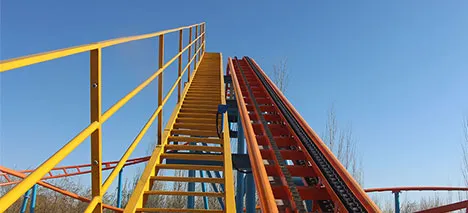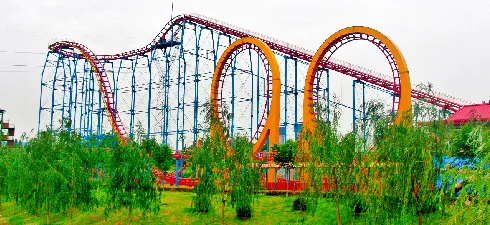2 月 . 18, 2025 11:16
Back to list
66M Truss Ferris Wheel (4-passenger cabin)
Roller coasters serve as thrilling symbols of adventure and innovation in amusement parks around the world. They come in a myriad of types, each offering a unique experience and catering to varying appetites for adventure. Understanding these different types can enhance one's appreciation for the nuanced engineering and creativity that goes into designing these high-speed marvels. Here, we dive into the diverse world of roller coasters, focusing on their distinctive characteristics, from design philosophies to passenger experiences.
The wing coaster further elevates the thrill, placing seats on either side of the track with no structure above or below the ridership. This design creates a free-floating sensation unparalleled by other coaster types. Key examples like The Swarm at Thorpe Park in the UK innovatively simulate the experience of flight, intertwining speed with swooping maneuvers close to the ground and through narrow gaps. Not to be overlooked are launched roller coasters, which propel riders to high speeds rapidly, omitting the slow climb typical of traditional coasters. This facilitates thrilling bursts of energy and acceleration, akin to being shot from a cannon. The Velocity Coaster at Universal's Islands of Adventure exemplifies the sheer power of launched coasters, boasting multiple high-speed launches that keep adrenaline junkies on the edge of their seats. Dive roller coasters are sure to attract those dreaming of heart-stopping drops. Characterized by a lengthy pause at the precipice of a vertical drop, these rides offer a tantalizing blend of suspense and exhilaration. Griffon at Busch Gardens Williamsburg showcases the dramatic effect of dive coasters with its jaw-dropping 90-degree drop that leaves riders in a thrilling free-fall. Family-friendly roller coasters provide accessible excitement for everyone, regardless of age or thrill tolerance. These rides focus on gentler speeds and modest heights, ensuring fun without the nerve-wracking intensity of their bigger counterparts. Coasters like Slinky Dog Dash at Disney's Hollywood Studios offer a perfect blend of fun and excitement, appealing to both children and adults. Each roller coaster type possesses unique qualities that cater to different tastes, making the choice of ride a personal journey on its own. Understanding the intricacies of these various types enriches the roller coaster experience, engendering even greater appreciation for the engineering marvels that dot amusement parks worldwide. With each ride offering its distinct thrill, enthusiasts continue to witness the ever-evolving creativity and innovation that define the roller coaster industry. As technology and imagination advance, we can only anticipate what the next wave of roller coaster experiences will bring, promising not just new heights, but also deeper engagement for every thrill-seeker.


The wing coaster further elevates the thrill, placing seats on either side of the track with no structure above or below the ridership. This design creates a free-floating sensation unparalleled by other coaster types. Key examples like The Swarm at Thorpe Park in the UK innovatively simulate the experience of flight, intertwining speed with swooping maneuvers close to the ground and through narrow gaps. Not to be overlooked are launched roller coasters, which propel riders to high speeds rapidly, omitting the slow climb typical of traditional coasters. This facilitates thrilling bursts of energy and acceleration, akin to being shot from a cannon. The Velocity Coaster at Universal's Islands of Adventure exemplifies the sheer power of launched coasters, boasting multiple high-speed launches that keep adrenaline junkies on the edge of their seats. Dive roller coasters are sure to attract those dreaming of heart-stopping drops. Characterized by a lengthy pause at the precipice of a vertical drop, these rides offer a tantalizing blend of suspense and exhilaration. Griffon at Busch Gardens Williamsburg showcases the dramatic effect of dive coasters with its jaw-dropping 90-degree drop that leaves riders in a thrilling free-fall. Family-friendly roller coasters provide accessible excitement for everyone, regardless of age or thrill tolerance. These rides focus on gentler speeds and modest heights, ensuring fun without the nerve-wracking intensity of their bigger counterparts. Coasters like Slinky Dog Dash at Disney's Hollywood Studios offer a perfect blend of fun and excitement, appealing to both children and adults. Each roller coaster type possesses unique qualities that cater to different tastes, making the choice of ride a personal journey on its own. Understanding the intricacies of these various types enriches the roller coaster experience, engendering even greater appreciation for the engineering marvels that dot amusement parks worldwide. With each ride offering its distinct thrill, enthusiasts continue to witness the ever-evolving creativity and innovation that define the roller coaster industry. As technology and imagination advance, we can only anticipate what the next wave of roller coaster experiences will bring, promising not just new heights, but also deeper engagement for every thrill-seeker.
Latest news
-
Top Amusement Equipment Manufacturer Rock n Roller Coaster & Carousel ManufacturerJun.10,2025
-
World's Scariest Roller Coaster Experience Ultimate Thrill & HeightJun.10,2025
-
Ultimate Thrill Ride Roller Coaster High-Speed, Safe AdventureMay.30,2025
-
Carousel Mansfield Rides Premium Indoor & Event SolutionsMay.30,2025
-
T3 Roller Coaster High-Thrill, Safe Ride for Theme Parks & ResortsMay.30,2025
-
Roller Coaster Cart Design Custom-Built & High-Safety Thrill Ride VehiclesMay.30,2025
